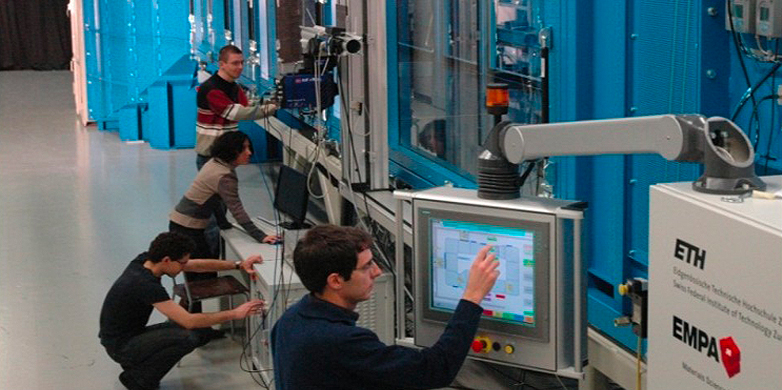A Master’s degree course for more energy efficiency in building
A new Master’s degree programme combines competencies from architecture and engineering to create comprehensive expertise in the planning of sustainable and energy-efficient buildings. The first students will start their course in autumn.
Forty per cent of Swiss CO2 emissions are generated by buildings. That is too much, says the Swiss Federal Office of Energy (SFOE) in its external pageenergy strategy 2050call_made. The 1.64 million Swiss residential buildings have huge potential when it comes to saving energy and cutting emissions. From 2020, buildings should supply themselves independently with heat from renewable sources and partly with power that they generate themselves. “This needs specialists,” says Christian Schaffner, Executive Director of the Energy Science Center (ESC) of ETH Zurich. “The framework conditions alone are not sufficient for successful energy transition.”
The ESC therefore set up a working group in the summer of 2013 together with the Rectorate and several professors to roll out a new, specialist Master’s degree programme for energy-efficient building planning. This resulted in the Master in Integrated Building Systems, a two-year Master’s degree programme which will be started this autumn for the first time. “Integrated, sustainable building systems play a key role for the national energy strategy,” says Schaffner. It is therefore not surprising that this new training programme was initiated by the SFOE.
Combining skills in architecture and engineering
To plan intelligent and energy-efficient building systems, architectural know-how is just as important as is expertise in engineering, explains Jan Carmeliet. He is professor for Building Physics in the Architecture department and Director of Studies of the new course. Although the four-semester, interdisciplinary Master’s degree programme is located in his department, it will be organised in close cooperation with the D-BAUG, D-MAVT, D-ITET and D-MTEC departments.
All students holding a Bachelor degree of the departments involved are permitted to enrol. At the same time, it is also open to university graduates with corresponding degrees, above all the graduates of the Bachelor degree programme in building technology of the Lucerne University of Applied Sciences and Arts. Thirty to forty students (mainly from Switzerland) will be selected from those who applied for the first year. International students are to be added later. The course will be taught in English.
The first semester will be adapted to the knowledge the students bring with them. Architects will improve their knowledge of mathematics and physics, while engineers will become familiar with architectural and aesthetic questions. This will result in two job profiles: architects with exceptional expertise in building technology and civil engineers with a very broad knowledge of buildings. Possible areas of work for the graduates will be major engineering offices, cantonal urban planning or general contractors that design and implement entire building parks.
Accelerating the implementation of intelligent technologies
“We often consume a lot more energy than necessary for heating, cooling and ventilating buildings,” notes Carmeliet. “In most cases this is simply because the technical building control is badly planned or managed.” Although intelligent technologies for building control are increasingly available on the market today, Carmeliet says that they are still not known sufficiently and only a few architects and engineers know how to combine such systems practically in the building.
For example, the temperature regulation of a building can today be adjusted automatically according to weather forecasts thanks to real-time data streamed from the internet. This saves a lot of energy. But such technologies have only been used in pilot projects so far because “it often takes years until they arrive in practical application,” says Carmeliet.
For that reason, the students will develop the possibilities of accelerating knowledge and innovation transfers from research to practice in the second semester together with a partner from the industry. “To this end, we need experts who not only have technical knowledge, but also know the socio-economic background of construction,” explains Carmeliet. Accordingly, the students will attend courses in microeconomics in addition to courses in materials, building technologies, simulation, project management and sustainability in construction.
Teaching benefits from interdisciplinary research
Some eighty per cent of the teaching will be covered by ETH professors from adjoining departments; this will be supplemented by partners from the areas of research and industry, including Empa, Eawag, Siemens and the engineering company Amstein + Walthert. ETH offers the optimal framework for such training, says Carmeliet with conviction, “Because we are already doing a great deal of interdisciplinary research in building technology.” As an example, he referred to the Monte Rose hut, the planning of which involved researchers from several departments. “Such experience will be integrated in the teaching to the benefit of the students.”
Information event on the Master’s in Integrated Building Systems
An information event on the new Master’s degree programme will be held on 7 March. Anyone interested can receive more information on the content of the course from the professors involved in the ETH’s main building (Audimax, room F30) from 4.00 pm. Adrian Altenburger from Amstein + Walthert will explain the practical expectations for graduates.
More information on the event and the course is available at: www.master-buildingsystems.ethz.ch.


